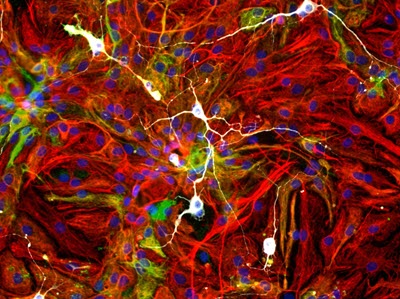Projects
- Spinal Cord Injury
- Alzheimer's Disease
- Neural Plasticity
 The work of the Spinal Cord Injury Group at the Center for Neural Repair focuses on augmenting regeneration of the adult spinal cord after injury. The injured spinal cord does not regenerate because: 1) cellular “bridges” that can support axonal regeneration do not naturally form in an SCI lesion site; 2) growth factors are not produced in the injured spinal cord to stimulate regeneration; 3) injured CNS neurons do not fully express a “growth program” to recruit new regeneration; and 4) the environment of the injured adult spinal cord inhibits regeneration due to the presence of inhibitory extracellular matrix molecules that form around the injury site, and due to the presence of inhibitory proteins on adult myelin that block regeneration.
The work of the Spinal Cord Injury Group at the Center for Neural Repair focuses on augmenting regeneration of the adult spinal cord after injury. The injured spinal cord does not regenerate because: 1) cellular “bridges” that can support axonal regeneration do not naturally form in an SCI lesion site; 2) growth factors are not produced in the injured spinal cord to stimulate regeneration; 3) injured CNS neurons do not fully express a “growth program” to recruit new regeneration; and 4) the environment of the injured adult spinal cord inhibits regeneration due to the presence of inhibitory extracellular matrix molecules that form around the injury site, and due to the presence of inhibitory proteins on adult myelin that block regeneration.
Neural stem cells exist in an intrinsically high growth state. When grafted to sites of spinal cord injury, neural stem cells survive and extend up to hundreds of thousands of axons into the injured spinal cord (Lu et al, Cell 2012; Lu et al, Neuron 2014; Kadoya et al, Nature Medicine 2016; Lu et al, J Clin Invest 2017; Poplawski et al, Science Trans Med 2017; Dulin et al, Nature Comm 2018; Rosenzweig et al, Nature Medicine 2018). Injured adult axons regenerate into neural stem cell grafts and form synapses; in turn, axons extending from grafts to the host spinal cord below the lesion site also form synapses onto host neurons. New neural relay circuits are formed that support partial functional improvement.
Building on this biology, our current research efforts are focused on a range of topics from basic discovery of genes that enable host axon regeneration, to late stage translational primate studies that are leading up to human translation. Our experimental techniques include genomic and epigenomic studies, cell biology, proteomics, bioinformatics, in vitro assays, in vivo models of SCI in rodents and primates, electrophysiology and behavior.
We are also using tools of bioengineering, nanotechnology and 3D printing to enhance and guide regenerating axons in the injured spinal cord and peripheral nerve.

